It’s that time of year when the shadows stretch long and tall, when goons and dames walk the streets, and when the sound of jazz fills the air. This Noirvember we look back at some of the classics from the 40’s and 50’s that shaped and defined film noir.
Double Indemnity (1944)
By Ben McDonald
In my limited experience with classic noir, Double Indemnity seems to me to exist as one of the purest distillations of the genre, unfolding as a slick psychological thriller amidst a claustrophobically bleak urban sprawl. Fred MacMurray plays Walter Neff, an insurance salesman whose sly smirk hides a morality teetering on a tightrope, apt to plummet downwards at the first sign of a breeze. On a house call, Walter meets Phyllis Dietrichson (Barbara Stanwyck), a femme fatale-type who eagerly agrees to stage the murder of her husband as an accident in order to collect double indemnity on his life insurance.
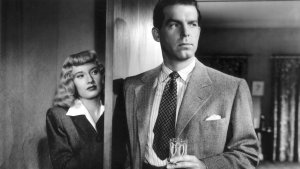 Perhaps what I find most memorably entertaining about Double Indemnity is how sleekly well-written and staged it is. The dialogue is fast, crisp, and histrionic. This isn’t how real people talk, but the pulpy brilliance of its thinly-veiled sexual innuendos is pure cinematic bliss. The cinematography is also a sight for sore eyes, hyper-stylized with dramatic low-key lighting and visually hypnotic shadow patterns. Though I admittedly haven’t seen enough classic film noir, ultimately I think Double Indemnity embodies everything the short-lived genre aspired towards: exploitative tales of amorality meticulously transpiring against urban hellscapes.
Perhaps what I find most memorably entertaining about Double Indemnity is how sleekly well-written and staged it is. The dialogue is fast, crisp, and histrionic. This isn’t how real people talk, but the pulpy brilliance of its thinly-veiled sexual innuendos is pure cinematic bliss. The cinematography is also a sight for sore eyes, hyper-stylized with dramatic low-key lighting and visually hypnotic shadow patterns. Though I admittedly haven’t seen enough classic film noir, ultimately I think Double Indemnity embodies everything the short-lived genre aspired towards: exploitative tales of amorality meticulously transpiring against urban hellscapes.
Laura (1944)
By Nick Adrian
One of the standouts and most beloved examples of the film noir genre, Otto Preminger’s 1944 film Laura continues to draw audiences in with its intriguing premise. It follows detective Mark McPherson (Dana Andrews) as he investigates the murder of beautiful young socialite Laura Hunt (Gene Tierney). As he delves deeper into the case, he begins to form a profound infatuation with the dead woman. Performances from Clifton Webb as Waldo Lydecker and a young Vincent Price as Shelby Carpenter help round out a cast of colorful characters, all contributing something different to the prolonged mystery of Laura’s death.
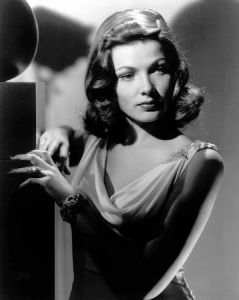 Though the detective narrative, mysterious female lead, moody lighting, and stark black-and-white cinematography- among other things- are all trademarks of the genre, Laura still manages to exceed expectations. Without giving anything further away, Preminger gives us a offering that stands on its own, whose twists and turns may catch even the most seasoned noir aficionado off guard. Laura’s ability to entice and surprise the audience has stood the test of time, influencing later works such as Alfred Hitchcock’s Vertigo and David Lynch’s Twin Peaks.
Though the detective narrative, mysterious female lead, moody lighting, and stark black-and-white cinematography- among other things- are all trademarks of the genre, Laura still manages to exceed expectations. Without giving anything further away, Preminger gives us a offering that stands on its own, whose twists and turns may catch even the most seasoned noir aficionado off guard. Laura’s ability to entice and surprise the audience has stood the test of time, influencing later works such as Alfred Hitchcock’s Vertigo and David Lynch’s Twin Peaks.
Mildred Pierce (1945)
By Kevin Jones
Mildred Pierce, directed by Michael Curtiz, is a unique blend of film noir and melodrama. Its framing narrative- the death of Monty Beragon (Zachary Scott) in the film’s opener and the eventual police interrogation of Mildred (Joan Crawford) about the crime- is strictly noir, as is the lighting from DP Ernest Haller. The heavy blacks and the reliance on shadows to create a sinister undertone for the film- some scenes are even acted out entirely with the shadows- while keeping it firmly planted in the noir style. However, the story underneath these shadows and the darkness of night is pure melodrama. Mildred is a woman who seemingly cannot catch a break, whether in love, business, or in death.
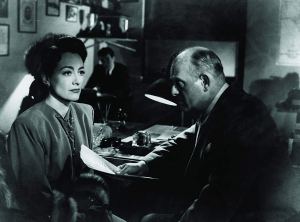 Yet, through it all, Mildred remains resolute. She builds a successful franchise of restaurants, all in the name of pleasing her spoiled daughter Veda (Ann Blyth). This is a deeply affecting film, one that shows the lengths a parent will go to and the things one will overlook to win the love and favor of their child. It is a doomed relationship, destined to end in tears and separation. However, no matter how many times Veda spits in her face or rips her apart, Mildred gets back up and tries again. Crawford’s powerful and raw performance defines the film, as well as Blyth’s cutthroat and heartless performance as her vicious daughter who cannot get enough of getting her way. Great characters fill the screen of Curtiz’s noir drama such as the sharp-witted Ida (Eve Arden) who adds considerable charm to the film at Mildred’s side, lightening the otherwise dark and moody film. Mildred Pierce is a sharply written work with great dialogue and characters bringing it to life, all while never losing focus of the broken heart propelling its sad story forward.
Yet, through it all, Mildred remains resolute. She builds a successful franchise of restaurants, all in the name of pleasing her spoiled daughter Veda (Ann Blyth). This is a deeply affecting film, one that shows the lengths a parent will go to and the things one will overlook to win the love and favor of their child. It is a doomed relationship, destined to end in tears and separation. However, no matter how many times Veda spits in her face or rips her apart, Mildred gets back up and tries again. Crawford’s powerful and raw performance defines the film, as well as Blyth’s cutthroat and heartless performance as her vicious daughter who cannot get enough of getting her way. Great characters fill the screen of Curtiz’s noir drama such as the sharp-witted Ida (Eve Arden) who adds considerable charm to the film at Mildred’s side, lightening the otherwise dark and moody film. Mildred Pierce is a sharply written work with great dialogue and characters bringing it to life, all while never losing focus of the broken heart propelling its sad story forward.
The Strange Love of Martha Ivers (1946)
By Matt Schlee
The Strange Love of Martha Ivers features one of the most star studded casts in noir history. Barbara Stanwyck, Kirk Douglas, Judith Anderson and Lizabeth Scott somewhat overshadow leading man Van Heflin, but it doesn’t stop the movie from being one of the most intriguing if slightly overlooked classics of the genre. While Lewis Milestone is better known for his big budget war films, this remains my favorite of his work.
 The film follows Sam Masterson (Heflin) as he returns to his hometown and reconnects with his childhood friend Martha Ivers (Stanwyck). He had tried to help Ivers escape from the control of her overbearing aunt (Anderson) and she is now trapped in a similarly domineering relationship with her husband Walter (Douglas), a wealthy and powerful man in the town. The cast keeps every scene fascinating, with each moment seemingly featuring a different pair of outstanding actors facing off. It keeps you guessing with one of the most intriguing and twist-filled screenplays in the history of the genre. The Strange Love of Martha Ivers is a noir masterpiece waiting to be discovered by more fans.
The film follows Sam Masterson (Heflin) as he returns to his hometown and reconnects with his childhood friend Martha Ivers (Stanwyck). He had tried to help Ivers escape from the control of her overbearing aunt (Anderson) and she is now trapped in a similarly domineering relationship with her husband Walter (Douglas), a wealthy and powerful man in the town. The cast keeps every scene fascinating, with each moment seemingly featuring a different pair of outstanding actors facing off. It keeps you guessing with one of the most intriguing and twist-filled screenplays in the history of the genre. The Strange Love of Martha Ivers is a noir masterpiece waiting to be discovered by more fans.
In A Lonely Place (1950)
By Alex Sitaras
In A Lonely Place sees Nicholas Ray exploring themes of masculinity and fame through the character of Dixon “Dix” Steele (Humphrey Bogart), a Hollywood screenwriter who flirts with becoming a washed-up Hollywood screenwriter. The morning after he coaxes a hat-check girl to come home with him to explain the plot of a novel he is being optioned to adapt, Dix discovers the girl has been murdered, placing him as a prime suspect in the murder case. After being brought in to the police department to answer questions, he meets Laurel (Gloria Grahame), a new tenant at his apartment complex, who defends his innocence. The two fall in love and Dix enters a remarkably fruitful period of productivity in writing.
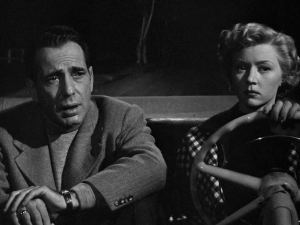 As Laurel becomes closer to Dix, she learns of his inclination to violent outbursts. She questions his innocence as well as their impending marriage. Ray’s Dix is an abrasive character, reminiscent of Jack Torrance in The Shining. The thing that keeps audiences on the edge of their seats throughout In A Lonely Place is Dix’s deeply callous nature and the fact he often acts counter to his interests- he does not attempt in the slightest to convey any sense of innocence or moreover grief that someone had died. He’s an unnerving character to watch and in part for that reason, In A Lonely Place sustains its tension and remains at the top echelon of film noir.
As Laurel becomes closer to Dix, she learns of his inclination to violent outbursts. She questions his innocence as well as their impending marriage. Ray’s Dix is an abrasive character, reminiscent of Jack Torrance in The Shining. The thing that keeps audiences on the edge of their seats throughout In A Lonely Place is Dix’s deeply callous nature and the fact he often acts counter to his interests- he does not attempt in the slightest to convey any sense of innocence or moreover grief that someone had died. He’s an unnerving character to watch and in part for that reason, In A Lonely Place sustains its tension and remains at the top echelon of film noir.
Night and the City (1950)
By George Morris
An early example of the noir genre, Jules Dassin’s Night and the City is filled to the brim with despicable acts in the seedy underbelly of London town, not afraid to show the stark brutality of the financial desperation of the time as reflected by Richard Widmark’s Harry Fabian. His ambitious hustling way bolster the film, and offer up the only slither of optimism (however misplaced) the film has. Through sheer force of will his actions and aspirations sink the lives of those around him, including Gene Tierney’s Mary Bristol, in a dazzling display of raw emotionality and honesty.
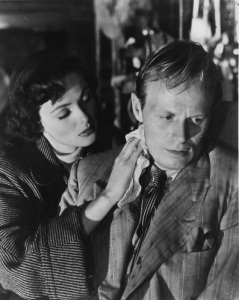 Critically bashed upon release, the film was seen as grotesque and indulgent in the obscene, but that since has been changed into the opinion of raw presentation of reality. The episodes, whilst formulaic at times, feel real. This is in no small thanks to the wrestling scenes within the film featuring genuine wrestlers engaging in prolonged and real fight scenes, leading to the injuries within the film having actual weight and gravitas. The film’s American ending is seen as the preferred one, offering up a lack of sympathy for Fabian during its climax and managing to end the film on a dismal note- one that matches the rest of the film. Whilst once quite difficult to watch, Night and the City remains an exhilarating and fascinating watch over half a century after its release.
Critically bashed upon release, the film was seen as grotesque and indulgent in the obscene, but that since has been changed into the opinion of raw presentation of reality. The episodes, whilst formulaic at times, feel real. This is in no small thanks to the wrestling scenes within the film featuring genuine wrestlers engaging in prolonged and real fight scenes, leading to the injuries within the film having actual weight and gravitas. The film’s American ending is seen as the preferred one, offering up a lack of sympathy for Fabian during its climax and managing to end the film on a dismal note- one that matches the rest of the film. Whilst once quite difficult to watch, Night and the City remains an exhilarating and fascinating watch over half a century after its release.
The Killing (1956)
By Dalton Mullins
 When thinking of the films of Stanley Kubrick, the genre of film-noir doesn’t necessarily spring to mind, yet two of his earliest films, Killer’s Kiss and The Killing, fall distinctly into this genre. Killer’s Kiss is more in the mold of an amateurish, student where Kubrick’s directorial genius was only presented in glimpses but The Killing is far more professional and granted us our first taste of the lofty heights Kubrick would achieve in his career. The Killing features many of the signature tropes of film-noir. The dark, grim, and moody lighting, the poor guy who managed to find himself in the wrong place, and the abrasive and abusive femme-fatale. Yet, Kubrick manages to add new dimensions to the film and was able to make the film a heist thriller. On the surface, The Killing appears to be a simple heist film with the elementary plot of an oddball group of small-time criminals and crooks attempting the robbery of a racetrack. Yet a gloomy and foreboding air drapes itself over the film and after one of the crooks informs his demanding and cold wife of the scheme, she manipulates him and inserts herself into the outcome of the robbery. Featuring a disastrous ending for many of the characters involved and the explanatory monologue throughout the film, The Killing contains all the trappings of a film-noir and with Kubrick at the helm, it elevates it above the many generic films of the genre.
When thinking of the films of Stanley Kubrick, the genre of film-noir doesn’t necessarily spring to mind, yet two of his earliest films, Killer’s Kiss and The Killing, fall distinctly into this genre. Killer’s Kiss is more in the mold of an amateurish, student where Kubrick’s directorial genius was only presented in glimpses but The Killing is far more professional and granted us our first taste of the lofty heights Kubrick would achieve in his career. The Killing features many of the signature tropes of film-noir. The dark, grim, and moody lighting, the poor guy who managed to find himself in the wrong place, and the abrasive and abusive femme-fatale. Yet, Kubrick manages to add new dimensions to the film and was able to make the film a heist thriller. On the surface, The Killing appears to be a simple heist film with the elementary plot of an oddball group of small-time criminals and crooks attempting the robbery of a racetrack. Yet a gloomy and foreboding air drapes itself over the film and after one of the crooks informs his demanding and cold wife of the scheme, she manipulates him and inserts herself into the outcome of the robbery. Featuring a disastrous ending for many of the characters involved and the explanatory monologue throughout the film, The Killing contains all the trappings of a film-noir and with Kubrick at the helm, it elevates it above the many generic films of the genre.
Sweet Smell of Success (1957)
By Kevin Jones
Noirs very often find a litany characters armed with guns while working as gangsters or detectives trying to solve some crime. Alexander Mackendrick’s Sweet Smell of Success is a little different, finding its characters still armed but not with guns. The dialogue sizzles and feels like a firecracker always set to go off, possessing the power usually reserved for a weapon. Following press agent Sidney Falco (Tony Curtis) as he deals with influential reporter JJ Hunsecker (Burt Lancaster), Sweet Smell of Success’ sharp-tongued and verbose script is befitting its press-focused characters as well as their roles in the world. These are not men who deal with guns, rather they fight their battles with words and are adept in verbal warfare, throwing double talk and insults at one another while exerting their influence on the world.
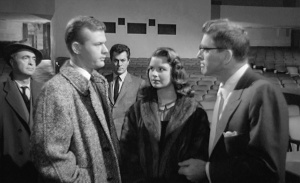 Mackendrick’s film is not just filled with terrific dialogue from writers Ernest Lehman and Clifford Odets, but also terrific themes as it explores the lengths these men will go to in order to control the world around them. Sidney’s efforts to break up a romantic relationship involving JJ’s little sister at the behest of JJ in return for space in his column underscores this and drives the plot, highlighting the lack of morality in this world of promotion and writing. At one point, Sidney turns to a woman he is using and says, “Don’t do anything I wouldn’t do. And that gives you a lot of leeway.” In the end, this defines the film. This is not a noir about the criminal underworld lurking under the city, using dark shadows to emphasize its hidden away nature. This is a noir about the criminals and immoral power-hungry men lurking in plain sight willing to do anything to anyone if it means they can get ahead. The shadows are still there, but the bright lights of New York City at night keep them from hiding, always putting them right in the spotlight while Mackendrick chisels away at them, revealing just how small and wicked they are.
Mackendrick’s film is not just filled with terrific dialogue from writers Ernest Lehman and Clifford Odets, but also terrific themes as it explores the lengths these men will go to in order to control the world around them. Sidney’s efforts to break up a romantic relationship involving JJ’s little sister at the behest of JJ in return for space in his column underscores this and drives the plot, highlighting the lack of morality in this world of promotion and writing. At one point, Sidney turns to a woman he is using and says, “Don’t do anything I wouldn’t do. And that gives you a lot of leeway.” In the end, this defines the film. This is not a noir about the criminal underworld lurking under the city, using dark shadows to emphasize its hidden away nature. This is a noir about the criminals and immoral power-hungry men lurking in plain sight willing to do anything to anyone if it means they can get ahead. The shadows are still there, but the bright lights of New York City at night keep them from hiding, always putting them right in the spotlight while Mackendrick chisels away at them, revealing just how small and wicked they are.
Elevator to the Gallows (1958)
By Matt Schlee
While film noir was largely restricted to Hollywood, it did see its fair share of copycats overseas. Perhaps none are as flawlessly executed as Louis Malle‘s debut film Elevator to the Gallows. One of the definitive French New Wave directors, Malle started his career with a bang with this atmospheric and wonderfully moody film noir. I’m not sure there’s a scene in cinema that moves me quite like watching Jeanne Moreau walk through the streets of Paris in the rain searching for her lover, who the audience knows to be trapped in an elevator.
 Elevator to the Gallows is much more slow and expressive than American film noir. It’s a fusion of the noir style with the French film aesthetic. The pair fuse beautifully though and create one of the defining classics of the genre, even if it was made late in the classic noir era. Despite its exciting story, beautiful cinematography, and stellar performances, Elevator to the Gallows’ most famous and influential element is its score, written and performed by Miles Davis. It is perhaps the defining soundtrack of film noir.
Elevator to the Gallows is much more slow and expressive than American film noir. It’s a fusion of the noir style with the French film aesthetic. The pair fuse beautifully though and create one of the defining classics of the genre, even if it was made late in the classic noir era. Despite its exciting story, beautiful cinematography, and stellar performances, Elevator to the Gallows’ most famous and influential element is its score, written and performed by Miles Davis. It is perhaps the defining soundtrack of film noir.

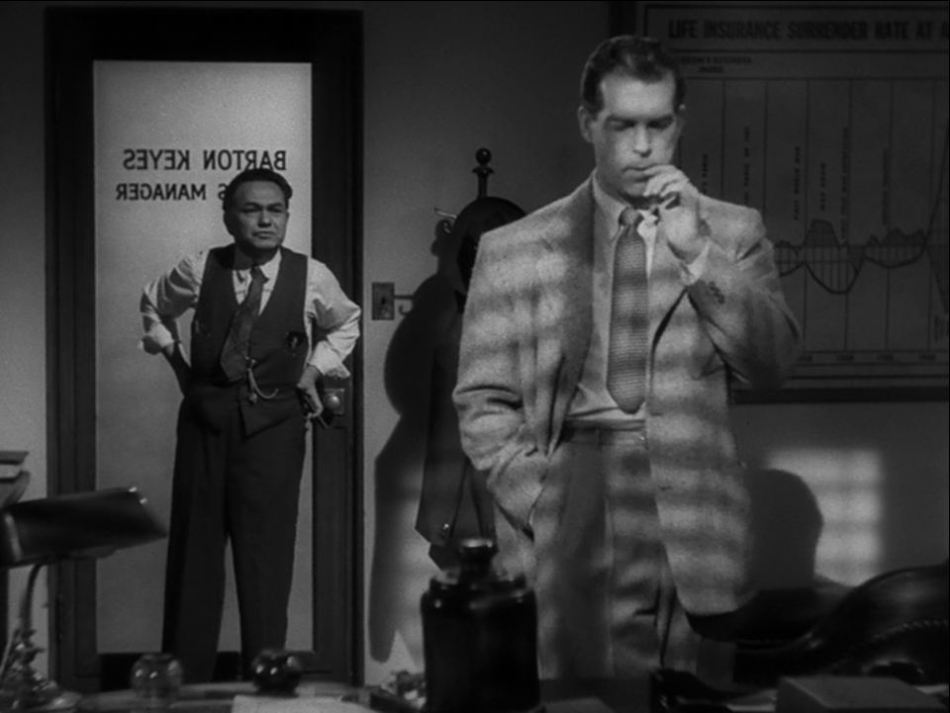
Fantastic article on some great noir movies
LikeLike